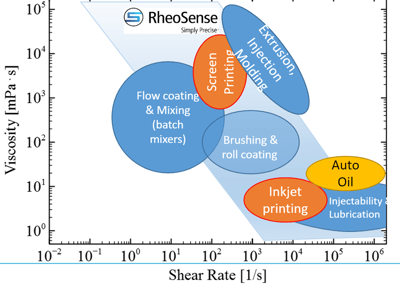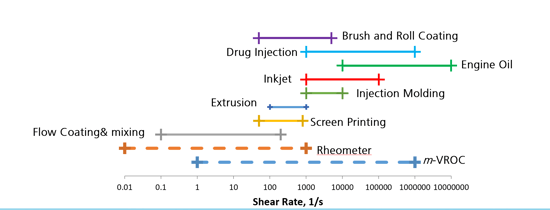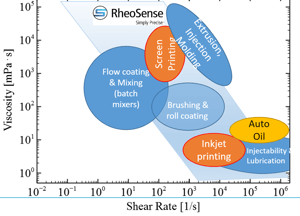Whether you work with printed electronics, touch displays (OLED), or any number of applications, including conductive inks, coatings, paints and pastes, viscosity is one of the key parameters that should be in your manufacturing process. Paints and inks are non-Newtonian fluids, meaning their viscosity is dependent on shear rate. Viscosity testing has shown us that inkjet inks must be tested at higher shear rates than paints and coatings in order to mimick the inkjetting process. Compared to paints and coatings, the shear rate ranges are much higher and can go up to even 100,000 1/s. When using viscosity as a function of shear rate testing, we are able to determine the behavior of of inks, paints and coatings.


Thixotropy is a commonly observed rheological behavior in both ink and paint formulations. Thixotropy refers to time dependent shear thinning property of non-Newtonian fluids (Mewis 1979). This is a reversible process in which certain materials that are thick or viscous under static conditions, but become thinner or liquify when shaken, stirred, or otherwise disturbed. The materials then reset or return to their more viscous state when allowed to stand after a fixed amount of time. One of the most commonly known thixotropic materials is ketchup.
Inks
Viscosity measures a liquids resistance to flow and when working with inks viscosity this can have a significant impact on manufacturing. Surface tension and viscosity determine the print quality of inks. These factors affect ink droplet formation, in turn, affecting the quality of the resulting printout. Throughout a press run, the properties of the ink’s viscosity can have several effects, on ink absorption, color strength and drying (Thai and Tupe, 2011).
Viscosity of inks depends on the components of the ink, including resins, pigments, and binding agents. Temperature also impacts the viscosity of inks. a temperature increase of 5.5°C can reduce the viscosity of a printing ink by 50 percent or more (DeJidas and Destree, 2005). Because such minimal changes in temperature can have such a great impact on ink viscosity, and therefore print quality, it is essential to maintain stable temperature when printing. Highly viscous paints can clog and potentially ruin the inkjet nozzle.
Conductive and ceramic inks are a fast growing applications, utilizing advancements in inkjet technology. With ink jettable conductive inks, precise liquid dispensing and patterning is now available for RFID (radio-frequency identification). Ink jettable ceramic inks allow for more sophisticated patterns with finer definition to be printed on ceramic tiles.
Paints
Viscosity measures paint resistance to spreading, which “plays an important role in its application” (Zenith Home Finishes). The viscosity of your paints must be adjusted depending on the application method you plan to use. The viscosity of paint is a key indicator of the paint’s intended use, as well as its ability to deliver an even and uniform coating to the desired surface (The House Painting Guide, 2013). Artists have been known to thicken acrylic paints to the point that they have to be applied to the canvas with metal scrapers as opposed to traditional paint brushes. For example, if you will be using a brush or roller, your paint will have a higher viscosity than if you are going to use a spray gun. If you try and use a spray gun on a highly viscous paint, you will have an uneven application and can even clog or ruin your equipment.
Similar to any other liquids, it is essential to measure the viscosity of inks, paints, and coatings. VROC® powered viscometers deliver accurate and reliable viscosity results that enable quick easy measurements on a QC standpoint along with high shear rates and small sample capabilities for R&D development. Register for our upcoming webinar to learn more about the data, calculations and material characterization of your samples provided with RheoSense VROC® powered viscometers.

Written by: Eden Reid, RheoSense Senior Marketing Associate
Reference:
- Yahia, C. Aïtcin and R J Flatt, Science and Technology of Concrete Admixtures, DOI (https://doi.org/10.1016/C2015-0-00150-2) 2016 [Science Direct]
- Z Żołek-Tryznowska, Rheology of Paints, DOI (https://doi.org/10.1016/B978-0-323-37468-2.00006-3), October 2015 [Science Direct]
- J Mewis; J.N. Wagner, N J, "Thixotropy". Advances in Colloid and Interface Science, DOI: 1016/j.cis.2008.09.005 2009 [Science Direct]
- Thai and R. Tupe, For your print information: Ink viscosity, February 2011 [Graphic Arts Magazine]


